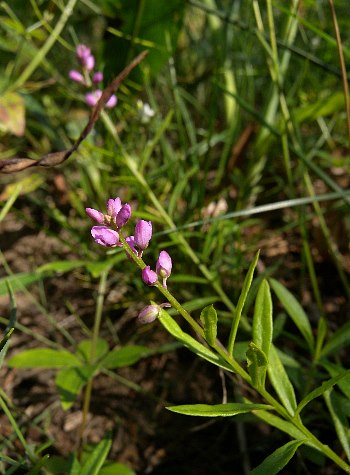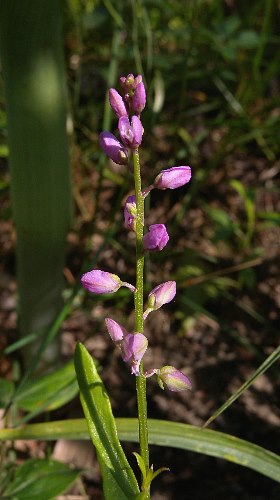
Each stem terminates in a spike-like raceme of purple flowers about ¾-4" in length. The central stalk of the raceme is light green to purplish green and glabrous. Each flower is about ¼" long and across when it is fully open, consisting of 3 petals, 5 sepals, several inserted stamens, and a pistil with a single style. Two sepals are enlarged, rosy pink to purple, and petaloid, forming a pair of lateral wings. The remaining three sepals are smaller in size, light green to purple, and ovate in shape. The 3 petals form a fringed tubular structure that surrounds the stamens and style; they are rosy pink to purple, often becoming more white toward their tips. The short glabrous pedicels of the flowers are light green to purple, slender, and often nodding. Sometimes a few cleistogamous (self-fertile) flowers develop toward the base of the raceme; they are bud-like and inconspicuous. The blooming period occurs from early to mid-summer and lasts about 3 weeks. Only a few flowers are in bloom at the same time. Afterwards, they are replaced by 2-celled seed capsules; each cell of a capsule contains a single hairy seed. In addition to the above-ground flowers, Purple Milkwort also produces cleistogamous flowers along underground stems. The root system consists of a taproot.

Cultivation: The preference is full or partial sun, mesic to dry conditions, and sandy soil.
Range & Habitat: The native Purple Milkwort is occasional in sandy areas of the northern half of Illinois, while in the southern half of the state it is absent (see Distribution Map). Habitats consist of upland sand prairies, upland sandy savannas, interdunal flats and stabilized sand dunes, and abandoned sandy fields. Habitat destruction, off-road vehicle use, and trampling by park visitors in heavily populated areas are threats to current populations of this plant.
Faunal Associations: Information about floral-faunal relationships for Purple Milkwort and other milkworts (Polygala spp.) is limited. The flowers of Purple Milkwort are cross-pollinated by masked bees (Hylaeus spp.) and other small bees. Even though Purple Milkwort and other milkworts have bitter foliage, they are sometimes grazed by White-Tailed Deer and possibly other herbivores (Martin et al., 1951/1961).

Photographic Location: A stabilized sand dune with scattered oak trees at Indiana Dunes State Park in NW Indiana.
Comments: The flowers of Purple Milkwort are small, but attractive and ornamental, resembling miniature orchid flowers if they are examined closely. It can be distinguished from other milkworts (Polygala spp.) in Illinois by its slender racemes with distinct pedicels and purple flowers. Other milkworts have stout floral spikes with pedicels that are absent or hidden, or they have slender racemes with white flowers. Pink Milkwort (Polygala incarnata) is something of an exception, but it has floral spikes that are more dense and leaves that are scale-like. In addition, the tubular structure of its flowers is more elongated than the corresponding structure of Purple Milkwort's flowers. Another common name of Polygala polygama is Racemed Milkwort.